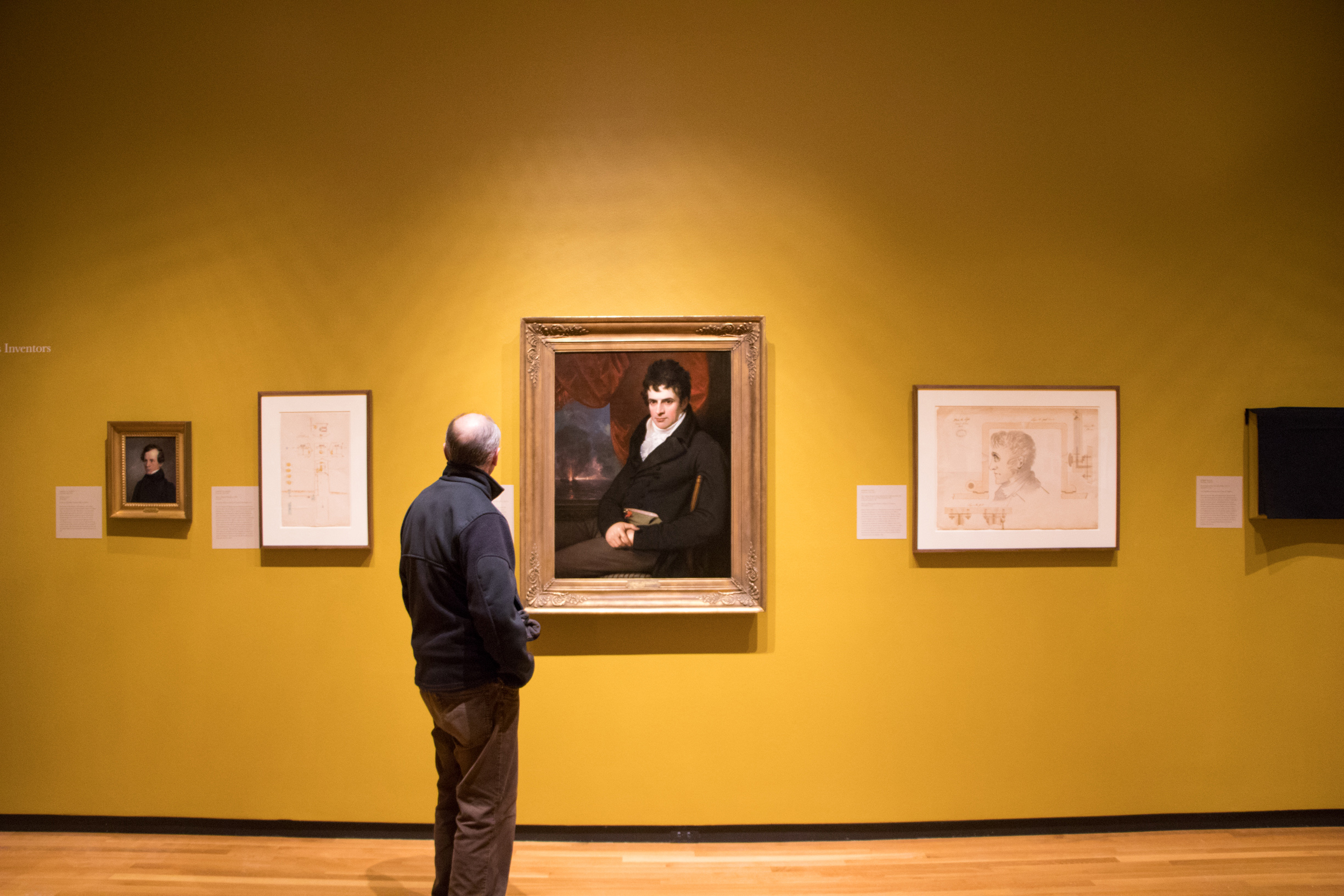BCMA highlights the achievements of Rufus Porter
January 24, 2020
 Ann Basu
Ann BasuAt first glance, the lower floor of the Bowdoin College Museum of Art (BCMA) looks like any other art exhibition: paintings, drawings, statues and other various forms of artwork are scattered throughout, set against yellow walls and accompanied by plaques detailing each piece’s history and artistry.
Upon closer examination, however, the exhibit houses an unusual variety of objects such as a chair, prints of 19th-century newspapers, a rifle, a clock and a drum. All of these come together to tell a complicated story of art, science, technology and innovation, forming a complex narrative about the nature of human progress.
The exhibit, entitled “Rufus Porter’s Curious World: Art and Invention in America, 1815-1860,” showcases the life and work of Porter, a 19th-century artist, inventor and engineer. Despite never having achieved the level of fame and success as some of his better-known contemporaries, Porter is viewed by those who study him as a polymath, a jack-of-all-trades or a Renaissance man, even earning the nickname “Yankee da Vinci” for his contributions to American art and science.
“[Porter] is not somebody that you would encounter in an Introduction to American Art History class,” said Frank Goodyear, co-director of the BCMA. “He has always been more tangential in mainstream histories.”
Despite his relative obscurity, Porter was incredibly prolific throughout his career, producing miniature portraits, murals, clockwork designs and even blueprints for a flying balloon, as well as founding and editing Scientific American, the oldest continuously published monthly magazine in the United States.
In addition to Porter’s own oeuvre, the exhibit also features the work of many of Porter’s contemporaries, highlighting the vastly different and yet interconnected artistic circles that Porter occupied during his lifetime.
Justin Wolff, one of the curators of the exhibit and a professor of art history at the University of Maine, elaborated on the reasons for bringing in such a broad array of objects.
“Rather than focusing exclusively on the work of Rufus Porter, [the goal of the exhibit] is to give everyone a bit more contact with the scene and how it operated at that historical moment,” said Wolff.
Rachael DeLue, a professor in American art at Princeton University, gave a keynote lecture about the exhibit entitled “New Inventions, Scientific Principles, and Curious Works: Rufus Porter and Nineteenth-Century Dreams of Interconnection” highlighting Porter’s central role in American advancement and his connections to many of the era’s leading innovators.
“Porter was at the forefront of all of these radical transformations in the 19th century in communication, in transportation, in standardization and in the very nature of knowledge acquisition,” said DeLue to a crowd in Kresge Auditorium on Thursday afternoon.
The exhibition also highlights another facet of Porter’s connectedness: his roots in Maine. “Rufus Porter’s Curious World” is one of three exhibits on display at the museum this semester celebrating Maine’s bicentennial in 2020. Although born in Massachusetts, Porter spent much of his young adult and adult life in what is now Maine, and was among many of the artists, scientists and other creative individuals that passed through Portland in the 19th century.
By demonstrating Portland’s place as a cultural hub during Porter’s lifetime, the exhibit confronts many popular stereotypes about Maine, as explained by Laura Fecych Sprague, a senior consulting curator with the BCMA and, along with Wolff, a co-curator of the exhibit.
“[Maine] is seen as this wilderness land,” said Sprague. “[People assume that] there couldn’t possibly be anything interesting going on here—it’s so far away. But that’s not true. With so many interesting things that have happened in the U.S. in its history and culture, there are great foundations to be found in Maine.”
Porter’s diverse talents and interdisciplinary methods make him an ideal subject for an exhibit at a liberal arts college, according to Goodyear.
“What makes this show particularly interesting is what it says about curiosity and creativity,” said Goodyear. “We are a liberal arts campus that wants to nurture creative dispositions. But how do you teach somebody to be curious? How do you teach that person to be creative? How do you teach that person to work beyond the boundaries of a particular field? That kind of multidisciplinary inquiry that’s at the heart of this project is, I think, so important in 21st century life.”
“[Porter] thought that these mechanical inventions would help improve our lives, would make our lives safer, would make life more efficient and better,” said Goodyear. “But he understood that art had to be a part of that—that art is a vital component to any kind of mechanical endeavor.”
However, as DeLue noted, Porter’s fascination with improving the human condition through technological advancement brings out a more complicated debate about the dangers of this innovation. DeLue pointed out the role of Eli Whitney’s cotton gin in furthering the slave trade as well as the effect of increased industrial manufacturing in provoking the climate crisis.
“The point I’m making here isn’t to say that Porter supported the slave trade—he was an ardent abolitionist—or that he was a chief cause of climate change or global warming,” said DeLue. “No. I’m simply making the point that lurking behind every technological utopia is its dystopian other.”
“Rufus Porter’s Curious World” will be on view at BCMA for the remainder of the semester.

Comments
Before submitting a comment, please review our comment policy. Some key points from the policy: